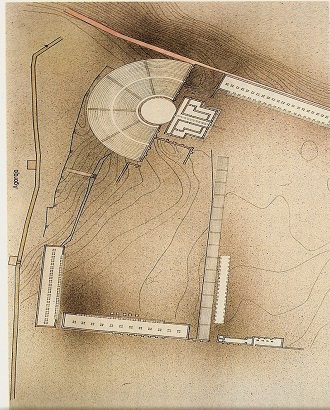

Agora
The agora of the city covered an area of 4 ha. It has the shape of a regular rectangle and is divided into 2 terraces connected with each other. Its construction was made around mid 3th century BC.
The entrance to the agora has a width of 8.30 m. It is an opening in a decorative wall, beautifully made ??of squared blocks, separating it from the inhabited area. Steps to the left lead to the stadium, on the right was a building with a size of 20,10 x 5,80 m, built on the wall of the agora. There were two more buildings and a porch with wooden colonnades. This might have been the prytaneioni, the office of the highest functionary of the koinon. During excavation of the monument, a statue with a latin inscription of the time of Augustus was found as well as an inscription of the 3rd century BC, which was dedicated to Artemis at the time when she was called with the Illyrian name Triteutas.
West of the prytaneion is a closed environment with a size of 18,20 m x 6.20 m without windows and only one entrance in the wall, built 3m lower against the back wall of the agora. Octagonal columns served to keep the floor of the first floor, which lead to the agora. It seems not to have been a building with public character, perhaps an arsenal for weapons. There is further a space, rectangular in shape, size 5.88 m x 7 m which likely has been an altar to the emperor, perhaps Augustus.
A number of Doric and Ionic columns are gathered in the square, coming from a monument built in the western part. From this monument comes an inscription CAESAR. Burial steles are transported to here from the necropolis through gate 6 . Several of them have been steles of the 3rd century BC, reused in the 1st century by flattening the old inscriptions and sculptening new ones.